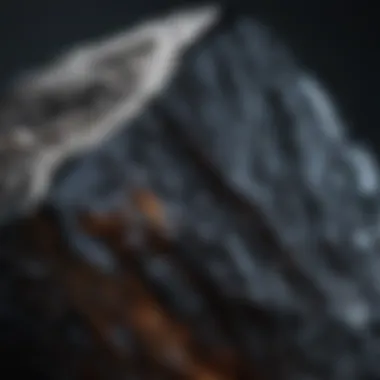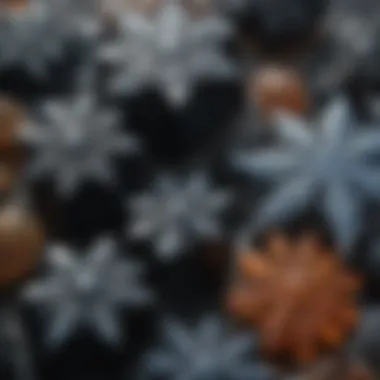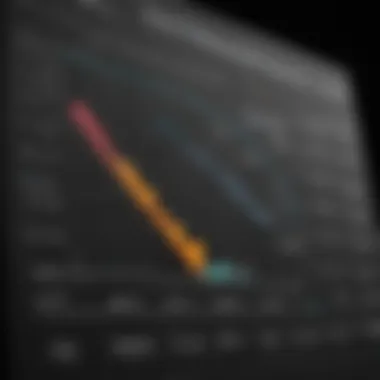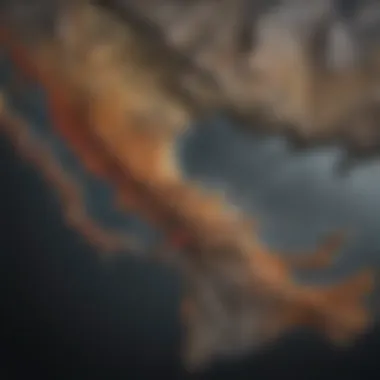Understanding Obsidian Price: Trends and Insights


Intro
The world of obsidian pricing is intricate, influenced by various factors that extend beyond mere aesthetics. Understanding what drives the market can empower collectors to make informed decisions. This article aims to dissect these complexities. It will cover essential elements such as market trends, regional variations, and authenticity. By gaining insights into these areas, collectors will learn how to evaluate this sought-after volcanic glass effectively.
Rock and Fossil Identification
For collectors of obsidian, identifying quality specimens is crucial. Not all obsidian is created equal. Many varieties exist, each with distinct characteristics.
Types of Obsidian
- Black Obsidian: The most common type, highly sought after for its sleek appearance.
- Snowflake Obsidian: Recognizable by white or gray inclusions resembling snowflakes.
- Rainbow Obsidian: Exhibits colorful iridescence, appealing to collectors interested in unique visual properties.
- Mahogany Obsidian: Features reddish-brown hues, offering a distinct aesthetic.
Characteristics to Look For
When evaluating obsidian, several key characteristics should be considered:
- Color Consistency: Uniform coloration often indicates higher quality.
- Clarity: Clear or translucent specimens are generally more valuable.
- Inclusions: Unique patterns or natural inclusions can enhance appeal, yet may affect valuation.
Tools for Identification
Utilizing appropriate tools can aid in the identification process:
- Magnifying Glass: Helps examine surface details.
- Polariscope: Assists in assessing optical properties.
- Field Notebook: Keeping notes on findings and locations can enhance future collecting efforts.
Market Trends
To grasp obsidian pricing, it is vital to understand prevailing market trends. Prices fluctuate based on demand and rarity. Recent years have seen an uptick in interest due to the rise of metaphysical properties attributed to obsidian.
Influencing Factors
- Cultural Significance: Varieties used in historical artifacts tend to command higher prices.
- Geological Source: Obsidian from specific regions, such as Mexico or the American Southwest, may be more desirable.
- Availability: Limited supply, particularly of unique types, can drive prices upward.
Expert Insights
Industry experts provide valuable context regarding pricing dynamics. Many potentite collectors share insights through forums and discussions.
"Understanding the origins and properties of obsidian can drastically influence your purchasing decisions. Collectors who invest time in learning about the material often see better returns."
This perspective underscores the importance of research in building a collection.
Ending
Prelude to Obsidian
The study of obsidian is vital for understanding its intrinsic and market value. Obsidian, a natural volcanic glass, captures attention not only for its striking appearance but also for its rich history intertwined with human civilization. In this section, we will cover important elements like the definition of obsidian, and its notable historical significance. By grasping these fundamentals, collectors can better appreciate the material they work with and the nuances that dictate its pricing.
Defining Obsidian
Obsidian is a naturally occurring, amorphous volcanic glass formed when molten lava cools rapidly. Its glassy structure is characterized by a lack of crystalline formation, making it different from most minerals. The lava cools so swiftly that there is little time for crystals to develop. Because of its unique properties, obsidian can have varying colors, including black, brown, and even green or blue, influenced by its mineral content.
Obsidian is often crafted into tools and ornaments, and it has become a sought-after material for collectors due to its aesthetic appeal and historical relevance. Understanding what obsidian is, and its geological formation helps collectors make informed decisions about purchases and collections.
Historical Significance
Obsidian has played a significant role throughout history, especially in prehistoric cultures. Its sharp edges made it a preferred material for creating tools and weapons. Early humans utilized obsidian for making knives, arrowheads, and scrapers, enhancing their hunting and survival capabilities. The durability and sharpness of obsidian gave these societies a technological advantage.
Moreover, many ancient civilizations, such as the Aztecs and the Maya, valued obsidian not just for functional use but also for ceremonial purposes. It was often used in rituals, making it an important cultural artifact.
The historical importance of obsidian shapes its perception in the modern market. Collectors are often drawn to the stories behind these artifacts, which can significantly impact the price and desirability of pieces.
Understanding the historical context of obsidian enriches a collector's experience and can lead to more informed investment decisions.


Factors Influencing Obsidian Pricing
Obsidian pricing is determined by several factors that collectors need to understand. These are not mere numbers in the market; they represent layers of geological and aesthetic qualities that can significantly impact the value. Knowing these factors helps collectors make informed choices, ensuring sound investments in this captivating mineral.
Geological Origin
The geological origin of obsidian significantly influences its price. Obsidian is formed from the rapid cooling of lava, leading to unique characteristics based on its source. Different geographic locations yield distinct varieties that are more or less valued. For instance, Apache Tears from the United States are known for their dark color and beautiful shine. Similarly, Mahogany Obsidian, found in the Western United States, possesses unique color patterns that are often sought after.
Other notable sources include Mexico, which is famous for its Snowflake Obsidian, characterized by white patterns resembling snowflakes. Each variety’s rarity can dramatically alter its market price. As a collector, understanding these origins can guide purchasing decisions.
Color and Clarity
The color and clarity of obsidian are critical elements that affect its price. Generally, deep, rich colors command higher prices. For example, black obsidian is often considered the standard, while others like green and blue obsidian may be rarer and thus more expensive. Clarity plays a role as well; the fewer inclusions and imperfections an obsidian piece has, the more valuable it tends to be. Clear and shiny pieces are more attractive to collectors, elevating their market value.
Furthermore, there are unique patterns within obsidian that can drive price. Varieties like Rainbow Obsidian, which displays a spectrum of colors when polished, are particularly valuable. Collectors should carefully evaluate aspects of color and clarity when assessing any piece.
Rarity and Availability
Rarity is another crucial aspect that influences obsidian pricing. Some varieties are abundant, making them more accessible and affordable. In contrast, rarer types, such as certain colored obsidian or pieces from specific regions, can be quite expensive simply due to their limited availability.
Market demand also plays a significant role. If a particular type of obsidian gains popularity among collectors or artisans, prices can surge. Conversely, if a variety becomes less sought after, its price may dip. It is essential for collectors to stay informed about market trends and audience preferences to anticipate value fluctuations.
Understanding these factors helps collectors formulate strategies to acquire valuable pieces while avoiding overpriced products.
Finale
In summary, the factors influencing obsidian pricing include geological origin, color and clarity, and rarity and availability. Collectors should consider these aspects when evaluating the market. This understanding can help them navigate the complexities of pricing, pairing value with aesthetic and collecting goals.
Current Market Trends for Obsidian
Understanding the current market trends for obsidian is vital for collectors and investors alike. This section provides insights into recent price fluctuations and compares obsidian to other minerals, enhancing the knowledge base necessary for informed decision-making in the realm of mineral collecting.
Recent Price Developments
In recent years, obsidian has seen various price developments. The rise in interest among collectors, especially in unique colors and rare types, has influenced pricing significantly. Recent data indicates that prices may have increased by approximately 15% in the last year alone, depending on quality and origin.
Factors such as increased online visibility through platforms like Reddit and Facebook have facilitated a wider audience, thus driving demand. Additionally, auction platforms and geological shows have attracted attention, leading to higher competitive bids for premium specimens.
Moreover, some geological experts predict that prices for specific varieties, like the highly coveted black obsidian from the United States, may continue to rise, establishing it as a distinct investment segment.
Comparative Analysis with Other Minerals
An examination of obsidian's pricing in relation to other minerals reveals interesting dynamics. Unlike quartz, which generally has a consistent price due to abundant availability, obsidian's market is more volatile. This volatility stems from its unique properties and limited supply from specific regions.
In comparison to gemstones such as topaz or amethyst, the price of obsidian remains relatively low, yet it has a growing niche due to collectors' affection for its historical and cultural significance.
- Key Comparisons:
- Price Stability: Obsidian's price is often acute to market demand, while gemstones may have more stable pricing mechanisms.
- Rarity Factor: Some obsidian types are exceptionally rare, driving prices higher when they come to market.
- Collector Interest: Recent trends indicate that obsidian is gaining popularity among new collectors, which can create price spikes as demand outpaces supply.
"The allure of obsidian lies in its multifaceted nature as a geological specimen and an art piece. Its pricing will likely evolve as more collectors become aware of its significance."
As the market for minerals continues to flourish, observing the current pricing trends of obsidian, alongside its comparison with other minerals, provides vital knowledge that can benefit collectors and investors.
Regional Variations in Obsidian Pricing
Understanding regional variations in obsidian pricing is crucial for collectors aiming to make informed decisions. The pricing of obsidian is not uniform across different regions; instead, it is influenced by several localized factors including geological characteristics, demand dynamics, and cultural significance.
Different types of obsidian come from varied volcanic origins and may exhibit unique qualities, contributing to their regional market values. In addition, local cultural appreciation for obsidian can drive up prices, especially in areas with a rich history of artifact creation or modern artistic uses. Recognizing these subtleties allows collectors to identify valuable pieces while navigating individual and market-level trends.
North American Obsidian
In North America, obsidian primarily originates from various volcanic fields, particularly in the western states like Oregon, California, and New Mexico. Here, the diverse colors and types of obsidian, such as Apache Tear and Rainbow Obsidian, can vastly differ in value. North American obsidian is generally well-known for its sharpness, making it a desirable material for both collectors and toolmakers.


Price trends in this region are often influenced by accessibility. For example, some areas may have restrictions on mining or collecting, which can drive up prices for locally sourced pieces. This area also sees a blend of commercialized and artisanal offerings, affecting market value significantly. On online platforms such as reddit.com, discussions about sourcing specific types often highlight these price influences.
South American Obsidian
South American obsidian, notably found in countries like Peru and Ecuador, includes unique varieties that are less common in other regions. These pieces often boast vibrant colors and patterns that contribute to their appeal. One notable type is the "Peruvian Obsidian," which is often black with greenish or reddish veins.
The cultural significance of obsidian in South American heritage can also inflate prices. In areas where obsidian has been utilized for centuries in both utilitarian and ceremonial items, its value can be particularly high. Artisans producing jewelry and sculptures from these stones often highlight this cultural backdrop, impacting their pricing strategies significantly.
European and Asian Varieties
In Europe and Asia, obsidian varies widely, both in availability and in market perception. Various countries have unique forms of obsidian, such as the well-regarded Spanish Black Obsidian and the distinctive Green Obsidian from Japan.
European markets tend to value historical artifacts and vintage pieces, which can result in higher prices for older obsidian items. Meanwhile, the Asian market often focuses on both the beauty and craftsmanship of obsidian jewelry. Additionally, variations in scarcity can significantly affect pricing. In places where specific types are hard to find, collectors are willing to pay premium prices.
The market is further complicated by the globalization of sales through platforms like facebook.com. This allows overseas collectors to access varieties that might not be available in their local market, sometimes creating bidding wars that elevate prices beyond expected levels.
"Understanding the subtleties of regional variations can equip collectors with the knowledge necessary to acquire valuable pieces in the obsidian market."
In summary, recognizing the regional variations in obsidian pricing enables collectors to better navigate their purchasing decisions and appreciate the diverse offerings this volcanic glass has to provide.
Authentication and Valuation
Authentication and valuation are critical concepts when dealing with obsidian. Collectors often invest significant resources into their collections, making the necessity of accurately determining both authenticity and value paramount. Authentic obsidian holds intrinsic properties and historical narratives that synthetic or misrepresented counterparts lack. Therefore, understanding how to identify genuine pieces is essential.
Identifying Genuine Obsidian
To identify genuine obsidian, one can look for several distinct characteristics. The texture is typically smooth and glass-like, with a shiny surface. Additionally, real obsidian fractures in a manner that creates sharp edges, which is an indicator of its glassy nature. The color can vary from black to brown, green, or even rainbow hues, depending on its geological formation.
Consider using a few practical tests:
- Visual Inspection: Examine the piece under natural light. Genuine obsidian exhibits transparency in some areas, while the color remains deep and rich.
- Scratch Test: Obsidian is relatively soft, rating around 5.5 on the Mohs hardness scale. A scratch test against a glass surface can confirm its authenticity.
- Weight Check: Real obsidian is heavier than synthetic ones made from plastic or resin. Holding the pieces can offer some comparative insight into their authenticity.
"The ability to authenticate obsidian often separates seasoned collectors from novices. Understanding these aspects enhances not only the value of your collection but also your appreciation of this remarkable volcanic glass."
Consequences of Misrepresentation
The misrepresentation of obsidian can lead to severe consequences for collectors. Buying what was believed to be genuine obsidian can result in financial losses and wasted time. Additionally, misleading information can diminish trust in sellers and the market, creating an environment of skepticism.
Moreover, the resale value of misrepresented pieces is generally non-existent. Once identified as fake, they may not attract any valid interest from genuine collectors. Collectors face a dilemma, as misrepresentation could even lead to legal repercussions depending on the context of the sale.
In summary, failure to authenticate and accurately value obsidian can undermine the overall investment and interest in this unique material.
Understanding these facets not only enhances investment strategies but also fosters a greater appreciation for the history and uniqueness of each piece.
Sustainability and Ethical Sourcing
In recent years, the growing awareness of environmental issues has propelled sustainability and ethical sourcing to the forefront of many industries, including the obsidian market. The importance of these topics cannot be overstated. Collectors and enthusiasts must consider the implications of their purchasing choices, as these decisions can influence not only the market but also the environment and communities involved in obsidian production.
Sustainable practices aim to minimize environmental impact while maximizing benefits to communities. In the context of obsidian, this includes responsible mining practices that do not lead to over-extraction or landscape degradation. By sourcing obsidian ethically, collectors contribute to the preservation of ecosystems and take a stand against harmful mining methods. Employing local labor and respecting property rights help ensure that communities benefit economically without sacrificing their surrounding environment.
Environmental Considerations
The extraction of obsidian can have a significant impact on the environment. When mining is conducted irresponsibly, it can lead to habitat destruction, soil erosion, and water pollution. Therefore, it is essential for collectors to be aware of these challenges and to support operations that prioritize environmental preservation.
Key considerations include:
- Ecosystem preservation: Well-managed mining ensures that natural habitats remain intact, allowing local flora and fauna to thrive.
- Soil health: Responsible extraction methods can maintain soil integrity and prevent erosion, which is vital for surrounding agricultural communities.
- Water resources: Minimizing water usage and preventing contamination protects vital freshwater sources used by both wildlife and local populations.
Fair Trade Practices
Fair trade practices in the obsidian market focus on ensuring that artisans and miners receive just compensation for their work, while also promoting safe working conditions. This aspect not only enhances the quality of life for workers but also fosters more ethical market dynamics.
Consider the following:


- Ensured fair wages: Supporting fair trade initiatives guarantees that workers receive adequate pay for their labor, which contributes to community development.
- Safe working conditions: Ethical sourcing prioritizes worker safety, reducing risks associated with mining operations.
- Community involvement: Fair trade practices engage local communities in decision-making, empowering them to establish sustainable practices that benefit their lives and livelihoods.
As collectors of obsidian, pursuing sustainability and ethical sourcing contributes significantly to the preservation of both the environment and the communities involved. Every purchase made responsibly can lead to substantial positive change, fostering a marketplace that values sustainability over mere profit. Support for sustainable practices ensures that obsidian remains a cherished material for generations to come.
Expert Insights on Investment in Obsidian
Investing in obsidian involves unique considerations due to its distinctive attributes and market dynamics. This section aims to illuminate different perspectives regarding how collectors and analysts view obsidian as an investment option. Recognizing these insights can help navigate the complexities of the market, allowing for informed decisions.
Collectors' Perspectives
Collectors of obsidian often emphasize two main aspects: aesthetic value and investment potential. Many enthusiasts are drawn to obsidian not just for its beauty but also for its historical and cultural significance. The various colors and textures of obsidian specimens can vary widely, contributing to their desirability.
From the viewpoint of collectors, certain varieties of obsidian, such as the Apache Tear or Snowflake Obsidian, may hold a particular allure. The rarity of these types often influences their market pricing.
- Emotional connection: Many collectors have an emotional bond with their pieces, which can affect their willingness to pay premium prices.
- Community insights: Engaging with communities on platforms like reddit.com allows collectors to share knowledge about trends and values.
Collectors also often discuss the prospects of an investment in obsidian. While market values can fluctuate significantly, some believe the long-term appreciation potential remains valid. Understanding market cycles can lead to better investment timing, which is essential for those looking to speculate or build a collection with investment in mind.
Market Analysts Views
Market analysts provide a more data-driven perspective on the investment potential of obsidian. They focus on trends and projected growth within the gemstone market. Analysts consider various economic indicators that influence pricing, such as supply and demand dynamics, global economic conditions, and consumer interest.
- Assessing trends: According to recent reports, the market for natural gemstones, including obsidian, has seen a surge in interest partly due to social media influence.
- Pricing dynamics: Analysts look at historical price data to identify patterns and predict future movements.
"The shifting interests of consumers and the rise of eco-conscious buying habits are creating a new landscape for gem collectors and investors alike."
Over the past years, some analysts have predicted that obsidian could become a more sought-after investment as the market becomes saturated with synthetic alternatives. They argue that authentic pieces, particularly those with certification, tend to retain value more effectively.
In summary, insights from both collectors and market analysts indicate that while obsidian possesses certain investment appeal, it is essential to remain informed on the specific market variables affecting its price. Understanding these perspectives equips collectors with knowledge, aiding them in making strategic decisions in their investment journey.
The Future of Obsidian Pricing
Understanding the future of obsidian pricing is crucial for collectors and investors alike. The market for obsidian exhibits dynamism owing to varying demand levels, production shifts, and emerging trends. By analyzing these aspects, one can anticipate changes that may influence both the collectors' strategies and market behavior.
Predicted Trends
Market analysts predict that the price of obsidian will be impacted by factors such as growing demand in the retail sector, particularly in crafts and jewelry. More individuals are exploring natural materials for sustainable products. Increased exposure to Asian markets could also enhance demand, especially where obsidian is linked to historical and cultural significance.
Experts observe that as awareness expands regarding the properties of obsidian, there might be a shift towards niche markets. For example, collectors may seek specific colors and textures, which could driving up prices for rare varieties and thus altering the overall market landscape.
In addition, environmental concerns are influencing the future. As sustainability becomes a focal point, the focus on ethically sourced obsidian may affect buying habits. Investors will need to be vigilant about how sustainability impacts price when valid sourcing methods gain popularity.
Investment Opportunities
The current trends in the obsidian market highlight potential investment opportunities. Specifically, collectors can diversify their portfolios by looking into lesser-known varieties. Investments in such pieces might yield high returns.
Moreover, collaborating with local artisans or businesses focused on fair trade practices can offer both ethical satisfaction and financial benefits. Engaging in local markets opens new avenues for sourcing unique obsidian pieces, often at a more favorable price point than more mainstream channels.
- Explore Emerging Market Demands: Keep an eye on social media trends that indicate rising interests in unique obsidian pieces.
- Invest in Education: Understanding the history and science behind obsidian will enhance decision-making.
- Assess Long-Term Value: Focus on quality and provenance as critical factors in purchasing decisions.
"In the world of collecting, knowledge is power. Understanding market shifts can lead to significant gains."
By identifying and assessing these factors, collectors can find themselves in a strong position to make informed decisions. The future holds great potential, but this hinges on cautious analysis and open-mindedness to new ideas.
Ends and Recommendations
The topic of conclusions and recommendations plays a crucial role in understanding the pricing dynamics of obsidian. This section synthesizes the insights presented throughout the article, allowing collectors to distill key information. The aim is to provide actionable advice based on thorough analysis of market trends, influencing factors, and expert perspectives. Collectors, both novice and experienced, will find value in grasping the nuances of obsidian pricing.
Summary of Key Points
- Market Influences: Obsidian pricing is shaped by various external factors including geological origin, color clarity, and scarcity. Knowing these can help collectors determine potential value.
- Regional Variances: Prices differ across regions such as North America and South America, affected by supply and demand dynamics. Understanding these can improve purchase decisions.
- Authenticity Concerns: Identifying genuine obsidian is essential. Knowledge of common fakes ensures collectors invest wisely. The ramifications of buying misrepresented pieces can be significant.
- Sustainability Factors: Ethical sourcing is gaining importance. Collectors increasingly prefer obsidian sourced sustainably, impacting their choices and pricing trends.
- Future Trends: Predictions indicate fluctuations in prices, highlighting the need for continuous monitoring of the market.
Strategies for Collectors
To effectively navigate the obsidian market, collectors should consider the following strategies:
- Research Thoroughly: Stay informed about the latest market trends. Resources like Wikipedia and Britannica provide valuable information.
- Network with Other Collectors: Engage with communities on platforms such as Reddit and Facebook. Conversations can reveal insights about pricing and sourcing.
- Consider Investing in Education: Attend workshops or seminars that focus on obsidian. Knowledge gained can enhance understanding and investment potential.
- Track Your Purchases: Maintain records of trends in your collection. Tracking the value of obsidian over time may indicate when to buy or sell.
- Explore Diverse Sources: Look for obsidian from different geographical areas. Unique qualities of obsidian from various locations may present new opportunities for collection.
Understanding the nuances of obsidian pricing is not just beneficial; it is essential for making informed decisions in this intriguing market.







